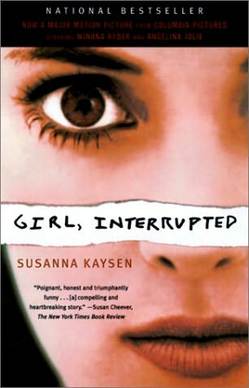This Week's Recommended Read: "Girl, Interrupted" by Susanna Kaysen

"Girl, Interrupted" is equally compelling in its original literary form.

Preview… The film adaptation of Susanna Kaysen's “Girl, Interrupted” is unequivocally my absolute favorite movie. Possessing such an unshakable fondness for the film, I was a bit hesitant to pick up the novel. I must declare that the book is mesmerizing and highly enjoyable. While the film quite accurately portrays the book, the literary version offers even deeper insights into the borderline between sanity and the lack thereof. It’s definitely worth reading, especially if you, too, have any fondness for the film starring Winona Ryder and Angelina Jolie, who won an Oscar for her role as Lisa.
Susanna Kaysen, the author and main character, recounts a series of non-sequential events as they pertain to her two-year tenure of in-house care at the famous McLean Psychiatric Hospital in the late 1960s. She voluntarily admits herself based on the consultation of a doctor who interviews her for just 20 minutes before diagnosing her with Borderline Personality Disorder and recommending a psychiatric reprieve in order to treat the depressive feelings that led Kaysen to ingest 50 aspirin.
Other residents in the teenage girls’ ward include—most notably—Polly, a schizophrenic whose failed self immolation led to a hideously disfiguring appearance; Lisa, a charismatic sociopath who makes a great deal of trouble for the hospital staff; Daisy, a seasonal patient who has two addictions, laxatives and chicken; and Georgina, a high-functioning paranoid schizophrenic who shares a room with Kaysen. Constantly governed by an intricate system of rules and regulations, the girls only have between 5 and 30 minutes to themselves at any given time of the day or night before a nurse or orderly comes round to perform “checks”. The few brief excursions outside of the hospital wall require a high staff to patient ratio, sometimes two to one.
Kaysen’s highly insightful memoir ponders the distinctions between crazy and not crazy and also differentiates between slow and fast insanity (both of which lead to mental paralysis) and treatment of the brain with drugs versus the mind with therapy. The clinically dry entry given by the psychological bible, the “Diagnostic and Statistic Manual of Mental Disorders”, for Susanna’s disorder is brought to life though accounts of her experiences with the psychiatric in-patient system as well as a candid look into her interpretation of these events; it is further supplemented by the use of scanned copies of her actual doctor’s notes and hospital forms. “Girl, Interrupted” is the perfect read for anyone who has ever questioned what it really means to be crazy and if escape is even possible when it is your own mind that has imprisoned you.
You may like this book if… you enjoyed the film adaptation; you have any experience with mental illness—whether from an academic standpoint or a personal one; you like witnessing substantial growth within a story’s protagonist; you enjoy reading true stories; you like looking at circumstances from a variety of angles; you enjoy pondering big questions; you are introspective; you want to have the insider perspective; you are intrigued by how the time period may shape perceptions of mental illness; you enjoyed Ken Kesey’s “One Flew over the Cuckoo’s Nest;” you would like to explore a novel that can be read quickly—easily within a single day; you like mulling over the possible interpretations of a compelling work of art.
You may not like this book if…you struggle with nonlinear plot lines; you have no interest in reading about the mentally ill or these types of issues hit too close to home for you; you expect the film and the book to have nearly identical story lines.
Melissa LR Handa is the founder and organizer for the Ann Arbor Classics Book Group and the Lead Books Contributor for AnnArbor.com. Her goal is to make classic literature more accessible to the everyday reader.

